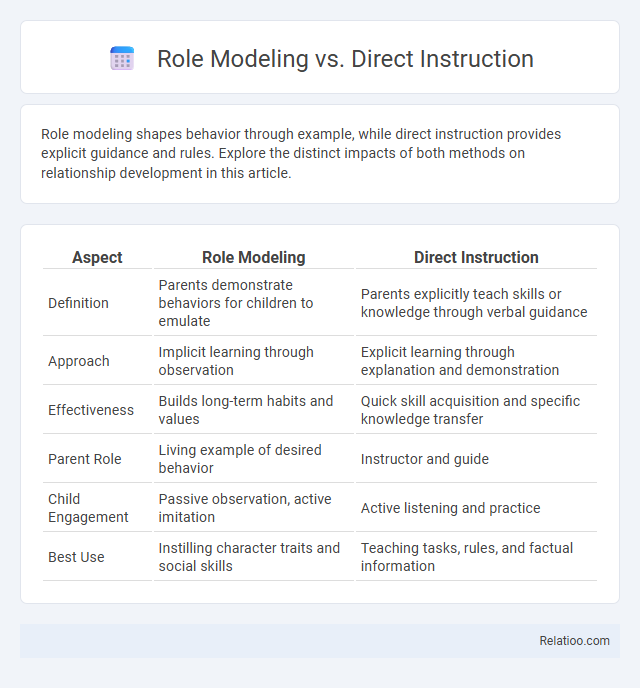Role modeling shapes behavior through example, while direct instruction provides explicit guidance and rules. Explore the distinct impacts of both methods on relationship development in this article.
Table of Comparison
| Aspect | Role Modeling | Direct Instruction |
|---|---|---|
| Definition | Parents demonstrate behaviors for children to emulate | Parents explicitly teach skills or knowledge through verbal guidance |
| Approach | Implicit learning through observation | Explicit learning through explanation and demonstration |
| Effectiveness | Builds long-term habits and values | Quick skill acquisition and specific knowledge transfer |
| Parent Role | Living example of desired behavior | Instructor and guide |
| Child Engagement | Passive observation, active imitation | Active listening and practice |
| Best Use | Instilling character traits and social skills | Teaching tasks, rules, and factual information |
Understanding Role Modeling and Direct Instruction
Role modeling involves demonstrating behaviors or skills for learners to observe and emulate, fostering implicit learning through example and social cues. Direct instruction provides explicit teaching with clear, structured guidance and step-by-step explanations aimed at ensuring learner comprehension and mastery. Understanding role modeling emphasizes observational learning and imitation, whereas direct instruction focuses on deliberate teaching methods to convey knowledge efficiently.
Key Differences Between Role Modeling and Direct Instruction
Role modeling involves demonstrating behaviors and attitudes for You to observe and imitate, emphasizing implicit learning through example rather than explicit commands. Direct instruction relies on clear, structured guidance with explicit explanations, providing step-by-step directions to ensure understanding and mastery of specific skills or knowledge. The key difference lies in role modeling's subtle, observational influence versus direct instruction's overt, verbal teaching approach.
Psychological Foundations of Each Approach
Role modeling leverages observational learning rooted in Bandura's social cognitive theory, where individuals internalize behaviors by watching others, enhancing intrinsic motivation and self-efficacy. Direct instruction is grounded in behaviorist principles, emphasizing structured guidance, explicit teaching, and reinforcement to shape desired outcomes efficiently. Modeling combines elements of both, allowing you to demonstrate skills and behaviors while encouraging active learning through imitation and cognitive processing, optimizing psychological engagement and skill acquisition.
Impact on Learner Motivation and Engagement
Role modeling fosters intrinsic motivation by demonstrating behaviors that learners aspire to emulate, creating an emotional connection and enhancing engagement through observation. Direct instruction provides clear, structured guidance which can improve focus and task-specific motivation but may reduce autonomy, potentially decreasing sustained engagement. Modeling combines observation with explicit explanation, balancing motivation and engagement by allowing learners to understand both the process and rationale behind behaviors or skills.
Effectiveness in Skill and Value Transfer
Role modeling fosters deep value transfer by demonstrating behaviors in authentic contexts, enhancing learners' intrinsic motivation and social understanding. Direct instruction excels in efficiently teaching specific skills through clear, structured guidance and repetition, leading to rapid skill acquisition. Modeling combines observational learning and explicit guidance, effectively bridging skill mastery and value internalization by showing both how and why behaviors are performed.
Contexts Best Suited for Role Modeling
Role modeling is most effective in social and professional contexts where observed behaviors influence learning and development, such as workplace mentorship, leadership training, and informal teaching environments. Unlike direct instruction, which relies on explicit teaching methods suitable for structured learning, role modeling excels in settings that emphasize implicit learning through observation. Environments that encourage interpersonal interaction, emotional intelligence, and ethical behavior benefit significantly from role modeling as a contextual approach.
Contexts Best Suited for Direct Instruction
Direct instruction excels in contexts requiring clear, structured guidance such as foundational skills acquisition, rote learning, and early literacy development where explicit teaching accelerates comprehension. It proves especially effective in classrooms needing standardized pacing and content coverage, ensuring uniform understanding across diverse learners. Environments with limited prior knowledge or those emphasizing measurable outcomes also benefit from the precision and clarity inherent in direct instruction methodologies.
Challenges and Limitations of Both Methods
Role modeling often encounters challenges such as inconsistent interpretation by learners and the risk of passive observation without active engagement, while direct instruction can limit critical thinking by emphasizing rote memorization over conceptual understanding. Modeling, though effective in demonstrating complex skills, may not cater to diverse learner needs due to varying cognitive abilities and lacks immediate feedback crucial for skill refinement. Both methods face limitations in scalability and personalization, impacting their overall effectiveness in diverse educational settings.
Integrating Role Modeling and Direct Instruction
Integrating role modeling and direct instruction enhances learner engagement by combining observational learning with explicit guidance, fostering deeper skill acquisition and behavior change. Role modeling provides authentic examples of desired behaviors, while direct instruction clarifies concepts and procedures, creating a comprehensive learning experience. Research shows that this integration boosts retention and application by addressing both implicit and explicit learning pathways.
Best Practices for Educators and Leaders
Role modeling fosters implicit learning through observation of authentic behaviors, while direct instruction provides explicit guidance and structured content delivery; modeling combines demonstration with explanation to clarify processes. Best practices for educators and leaders emphasize integrating these approaches by consciously exemplifying desired behaviors, delivering clear, step-by-step instructions, and engaging learners through active demonstration to enhance understanding and retention. Effective use of feedback and reflection further solidifies learning outcomes by encouraging self-awareness and continuous improvement.

Infographic: Role Modeling vs Direct Instruction
 relatioo.com
relatioo.com